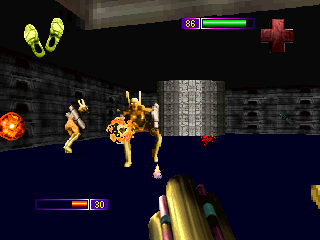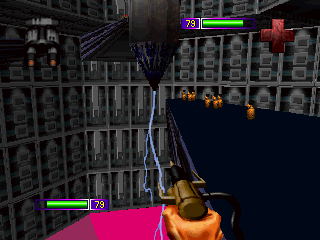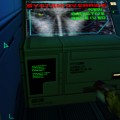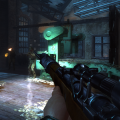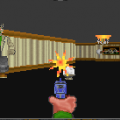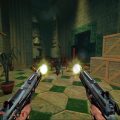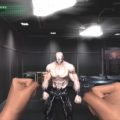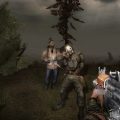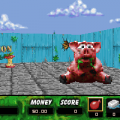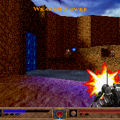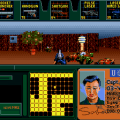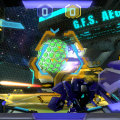So Nathan, tell us a little about your background. What were you doing before you ventured into the video game industry?
As an undergraduate at Cornell University, I first became interested in computer graphics after taking a class taught by Prof. Don Greenberg. I received a master’s degree at Brown University under Prof. Andy van Dam and then worked as full-time research staff in the Brown University Graphics Group for a few years doing research in 3D user interfaces and animation systems. During that time, I did a contract to make a 3D graphics demo for my fraternity brother Brian Yen when he was on the demo team at Sun Microsystems. I spent two weeks in Silicon Valley for that job, had a blast, and knew eventually I was going to end up in California. In 1994, I decided to leave the nest and make the move. By then, Brian had left Sun to start Any Channel, so I went to work for him.
What did the Silicon Valley job entail? That is, can you tell us about the demo and its purpose, and why you enjoyed the job so much?
Sun Microsystems needed a multi-processor graphics demo for a two-processor x86 running their new Solaris OS for some trade show. (In hindsight, 1994 was pretty early for a two processor x86.) Brian had a water fountain demo that he had shown at SIGGRAPH some years before, I multi-threaded it to run faster with two processors than one. I also ported one of the Brown Graphics Group demos to this platform, which was okay since the Graphics Group had sponsorship and a working relationship with Sun already
The job was great fun because it paid well, I worked very hard to impress Brian and his bosses at Sun, Brian and I ate in nice restaurants in Palo Alto every night, my sister and other good friends lived in the area, the weather was fantastic – it was obvious this was my future.
I’m not even in the computer industry and that sounds like a dream job…
How exactly did you come to join Any Channel? Can you or the other guys tell us how the team was formed?
Any Channel was founded by Brian Yen, Irene Pan, and Phil Lam. Brian, as I mentioned before, was working at Sun writing graphics demos and wanted to start his own company. Irene was an engineer at Sun. Phil was a friend of Brian’s from his undergraduate days at Cornell University. So Brian was business, Irene was engineering, and Phil was marketing. Shortly thereafter, Russ Pflughaupt joined as a fourth partner, Russ was a graphics performance engineer at Sun. The name Any Channel came out of a long-term vision of settop boxes, where (in the future) you could turn to “any channel” on your TV and there would be some entertainment service provided by the company.
I showed up a few months later, eager to start my new life as a Silicon Valley engineer, and was hired as the first employee pretty much solely on Brian’s recommendation. I don’t recall being interviewed by my boss Russ, heh. I was lucky, Russ turned into a great friend and mentor to this day. Our second employee joined a few months later, a very talented artist named Kenta Williams who did all of the audio for PO’ed as well as contributing artwork for a number of levels and monsters.
We didn’t have an office yet when I joined. Brian was renting a house in Palo Alto, so the living room became our HQ, stocked with the Mac (we only had one!), the 3DO test station, and a bunch of old Sun Sparcstation workstations that had been, um, “borrowed” from friends at Sun. I loved the scene from the movie The Social Network where the Facebook guys are all coding in the Palo Alto living room because I lived that in 1994, except without the swimming pool! (And without becoming billionaires…)
Sounds like every day was business casual day at Any Channel!
How was PO’ed conceived? I’m dying to hear this one, given the intensely surreal nature of the game.
I suspected the “How was PO’ed conceived?” question would get vastly differing answers if I asked the guys for their versions of the history. So I did just that.
My initial memory when I first joined was that there were three or four potential game ideas on the table. We had a meeting and discussed the pros and cons of each idea and ended up choosing the first-person shooter idea. I couldn’t recall the other potential games.
I’m in touch with Russ daily via instant messaging. He didn’t remember the other game ideas either. He remembered us choosing the first-person shooter because that was our area of engineering expertise. He also didn’t remember any grand plan for the PO’ed game design, he remembers lots of game elements being invented on the fly as the game was written.
Luckily I sent Brian an email – he wrote the following lengthy reply.
There were a few things we knew we wanted to do right from the start:
- Full 3D because that’s what the development team was most capable of doing and no one had done it yet in commercial game. [PO’ed shipped on the 3DO eight months before Quake shipped on the PC. -Nate]
- Non-violent
- Different from what’s out there
The first concept Irene, Phil, and I developed was an educational game of navigating through a human body, like the old Fantastic Voyage movie, fighting antibodies and other human body defenses. But we concluded that it would not sell, as the only thing that can retail for $50+ at that time was something with a more violent angle, and educational titles usually tanked. So, back to the drawing board.
Russ joined the company and convinced us that a first-person 3D game was the way to go, which we agreed but wanted to stay on the non-violent theme. We brainstormed many ideas and came up with the chef on alien planet, basically Steven Seagal’s Under Siege + Alien. Shooting aliens seemed to satisfy the non-violent requirement, since killing aliens is ok and killing humans is not. And since the chef was the last person left alive, there’s no other human harmed in the making of this video game.
Then we proceeded to produce something different than anything out there…
First off, the main character, the chef Ox, is heroic not because he’s a martial arts expert, that would be too cliché. He’s a chef after all, so he became this fat ass armed with a frying pan. We needed to provide surprise encounters where you think the fat ass would surely die, but he manages to escape by the thin hair of his wits. Or by the sheer fact that a fat ass met his match – another ass.
As we developed the levels, various vehicles were put in place, because I developed a whole bunch of physics simulations for things like motorcycle, jet pack, and the back flips. As the game progresses, we wanted to integrate these vehicles into the game levels, and as we gained experience in gameplay design and monster AI, the levels started to get more sophisticated. There was no grand plan initially in designing the levels. Also, since it’s an alien world, we had full design freedom to imagine what aliens would do.
The character development and surreal environment followed the initial design trajectory of providing the thrill of a first-person shooter while not killing any human beings and trying to differentiate from other games. Most other games, even those involving alien and monsters, are done in a serious manner. So we tried to throw some humor into it. For instance, when using the power drill the screen could get so splattered with blood that you couldn’t see, so the wiping hand would wipe the blood off your face.
The name PO’ed came about as we tried to come up with a title that expressed the emotion of the character, but simple, short and catchy.
Some of the monster design owed its eccentricity to one of our investors, he sculpted the Butt Monster and several other characters like the Amazon (who we called Susan after the Stop the Insanity weight-loss infomercial woman Susan Powter). I think the Butt Monster was his crowning achievement. We wanted a physical representation of a metaphorical “walking asshole” and he came back with that masterpiece. We all laughed our heads off when seeing that sculpture for the first time. I may still have it somewhere.
-Brian
So there you have it. Brian’s version of the history certainly sounds the best. I’ll see if I can get a current picture of him with the Butt Monster sculpture! 🙂
If Brian still has that sculpture, I’d love a pic for the interview page. Give him my thanks for his generous contribution. And the fully 3D levels indeed set PO’ed apart from the competition, but I hadn’t realized it beat Quake to the punch by so many months!
Who exactly did sculpt the Butthead monster? Brian said “one of our investors” did: does that mean the people who helped fund the project also pitched in creatively?
The initial funding for the company came from the four principal owners, Brian, Irene, Phil, and Russ. The extra “investor” was a relative of Brian who pumped in some cash along the way. And yes, he had some skills in creating sculptures (of walking butts) that we utilized.
Dan mentioned on his portfolio site that the levels were made using a text editor. How did that work exactly? And were the designers given free reign to explore any ideas that came to mind? Or did they have specific guidelines to follow?
I had worked with Dan in the Brown University Graphics Group. We developed a 3D modeler application with which artists could develop 3D models and 3D user interfaces. So when it came time to create 3D levels for PO’ed, I thought Dan was the perfect candidate to make them. He made a few levels as a trial and everyone was blown away.
Our level description was a very simplistic text-based “specify each coordinate of each polygon of each object”. I’m sure Dan used a text editor at first, but I also thought I whipped something up for the Brown Graphics Group modeler where Dan could use the modeler to create the level and export it in the Any Channel object file format.
If I can get technical for a second, each level consisted of a few hundred objects (sets of polygons) from which an axis-aligned BSP (binary space partitioning) tree was generated. The BSP tree is a common data structure in computer graphics from which the proper rendering order of the level’s objects can be determined from any viewpoint. As a further optimization, the polygons within each object had their own pre-computed rendering order using an old (and forgotten, at least by our friends developing a different 3D 3DO title at the time!) technique from the early days of computer graphics called Shumacker’s algorithm. This last optimization placed some restrictions on the allowed orientations of the polygons within any particular object. Fortunately, I knew Dan could understand this technical restriction and still be able to create interesting levels despite the restriction. Dan had lived with technical restrictions and shortcomings in my software for years while I was at Brown, why stop now?
Dan should chime in on any guidelines we gave him for general level design. I don’t think there were any…heh. The fact that it was an alien world probably really did mean there were no guidelines, Dan could use his imagination.
PO’ed was originally created for the 3DO Multiplayer System, correct? What made Any Channel choose that platform?
That was another question for Brian, so I forwarded it on. Here is his reply:
PO’ed was created for the 3DO system because at that time, it was the most capable 3D system around, even more powerful than the PCs, and we were all experienced 3D programmers and determined to make a full six degrees-of-freedom real 3D game. And we did, we were the first full 3D mass consumer game in the world, it came out before Quake. In fact, there weren’t any real 3D title on 3DO, Russ did a fantastic job in optimizing the code, 3DO was very impressed. They didn’t think this sort of full 3D could be realized on their own hardware.
3DO offered $1M to publish the deal. But we didn’t take the deal… in retrospect that may have been a better business decision. But then if we did accept that deal, we would not have been able to publish it on the Sony PlayStation the following year.
-Brian
I’ve spent the past few days trying to wrap my head around turning down the $1M development deal, Russ and I don’t remember that! I suppose we were young and ambitious and wanted to keep our creative freedom rather than handing over all our intellectual property (mainly the 3D graphics engine) to 3DO. Still, $1M seems like a lot to offer for a four-person development team. Plus we were starting to have doubts about 3DO’s future, with that $700 price tag and the Playstation on the horizon.
And sure enough, the Sony PlayStation blew all the other CD consoles out of the water, thanks to its low price and fast hardware. Was PO’ed ported to PlayStation on account of the 3DO’s sinking ship? or were there other factors?
Any Channel became very interested in the Playstation when it was introduced. I think we would likely have pursued it as a platform even if 3DO remained successful, it seemed clear Playstation was going to be huge. After we shipped PO’ed on 3DO in November 1995, we were approached by Accolade to port PO’ed to the Playstation.
The PS1 port had a lot of improvements and refinements, too: the Boot Camp level, the nicer-looking menus, and fewer bugs. Did you see the PS1 as an opportunity to touch up the game while you had the chance?
Yes, we tried to make some improvements for the PlayStation version of PO’ed, but from a technical standpoint I have to admit I was always a little disappointed that we didn’t do more.
In particular, on 3DO we used 6-bit (64 color) bitmaps for all the levels and monsters since that was the native format of the 3DO hardware. PlayStation didn’t have 6-bit, they had 4-bit (16 colors) or 8-bit (256 colors). We ended using 4-bit bitmaps in nearly all cases, resulting in what I considered a washed-out look on the PlayStation when compared to the 3DO. There were some exceptions, like the Butt Monster, which were promoted to 8-bit.
We also had a chance to increase the resolution of the bitmaps so the game would look less pixellated. The Butt Monster and maybe a few other bitmaps like the weapons selection menu got promoted to a higher resolution, but again those were the exceptions. I proposed computing the surface area of all the polygons in our levels and then computing the surface area covered by each bitmap. Increasing the resolution of ALL the bitmaps was too much work and we would have exhausted the system’s memory, so my idea was to figure out which bitmaps covered the majority of the level and just increase the resolution on those. I was vetoed on the grounds that we already had way too much work to do, even though I swear this would have taken me about an hour to do. I think the game would have looked much better.
One nice technical point was that the game ran faster on the PlayStation, it was just a faster machine than the 3DO. It’s always nice to get “free” framerate improvements. The Boot Camp level was fun to make, I remember I had to add the automatic monster resurrection so the level could be played forever.
Unfortunately, I’ve always remembered the PlayStation port more for the missed opportunities.
That is kind of a shame…but the PlayStation port played a helluva lot better than the 3DO version, and I think that’s what counts (that and being more accessible on a cheaper and more successful console). I played it on the PlayStation first when I was a kid, although I remember seeing copies of 3DO PO’ed in the used game stores of my neighborhood (before I knew what a 3DO was).
PO’ed seems to be Any Channel’s one claim to fame. Did your team produce any other games?
After PO’ed, we turned the game engine into a product called Any World. It was our 3D game engine, with integration with Lightscape Technologies, a company developing a radiosity-based renderer. One could use Lightscape to create very realistic lighting and shadows which we incorporated into the Any World engine.
SegaSoft used Any World for a PC game called Vigilance. While the 3DO PO’ed won awards like Videogame Advisor Game of the Year and Die Hard Game Fan’s Best Action Game of the Year, Vigilance landed a Worst Game of the Year. (For awhile, my online profile accurately said I wrote “award winning videogames”.)
A variant of Any World was used by Electric Communities, one of the early online virtual worlds. We called this a 2.5-D renderer, where each chat room was a static scene (and therefore 2D) with beautiful artwork, but individual objects in the room had depth so the avatars could move in front of or in back of things. (Russ had left Any Channel by this point and was a contractor for Electric Communities, so things went very smoothly.)
The next year, we were kicking around various game prototypes, like a 3rd-person action game with a biker chick, or a full 3D Marble Madness, but it was tough finding funding (we had around ten people at this point). When the opportunity came to be acquired by Micron, Brian took it. The engineering team (myself and three others) became the Direct X team at the division of Micron that was formerly the graphics card maker Rendition. And that was the end of Any Channel.
Sounds like it was a fun ride while it lasted, anyway. What are the most important things you learned from your experience at Any Channel?
That last question…was a tough one, that was 20 years ago!
On the technical side, I learned how to write code for a closed, embedded platform. Writing for a 3DO or a PlayStation is very different than writing for a PC. The amount of computing resources (memory, CPU power, graphics power) is so constrained that you learn to take advantage of every opportunity that presents itself in order to save resources. It’s a great mindset to have as a programmer, especially in my current job writing graphics code for NVIDIA’s embedded team.
On the non-technical side, I learned about working very hard with a small team. We were a relatively close-knit bunch and I’m still very good friends with the guys today even though we’ve all gone our separate ways. I’ve tried hard to foster good team dynamics everywhere I’ve worked since Any Channel. Make the job fun and always keep a good sense of humor!
Do you have any advice for aspiring game designers?
Me give advice?! I’m happy PO’ed garnered a small cult following, but it’s not like it was a hit or anything, so I don’t think I’m in much of a position to give game development advice. I guess as a computer graphics programmer, one piece of advice is to never stop learning. There’s so many advanced graphics techniques these days, keep researching, keep learning, keep reading SIGGRAPH papers. To the game designers, it’s an exciting time with phones and tablets and a possible virtual reality boom around the corner. New game concepts and interaction paradigms are waiting to be invented. But above all, have fun. When I look back at PO’ed, I have nothing but good feelings because it was a really fun time.
***
Nate Huang has worked professionally in computer graphics for over 25 years. He is currently a senior software engineer in the Automotive Graphics team at NVIDIA responsible for providing high-performance graphics software to a growing number of automobile manufacturers like Audi, BMW, and Tesla Motors. He resides in San Jose with his wife and two sons.
